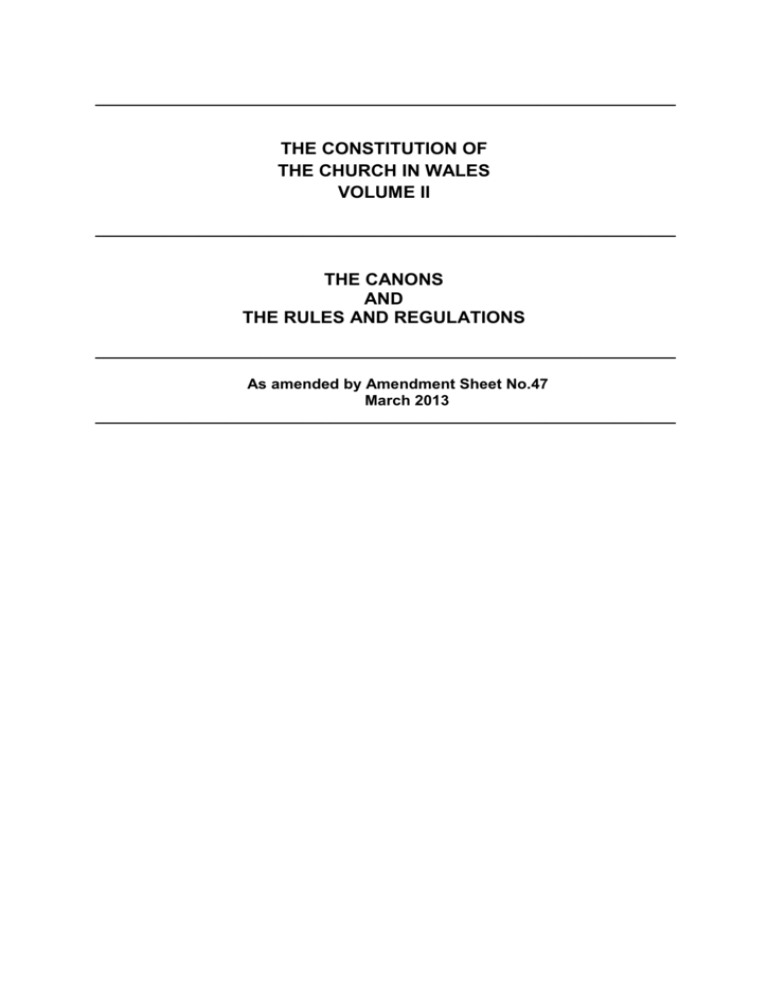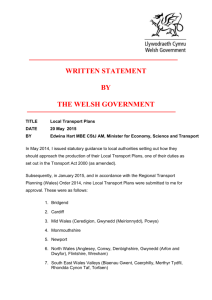the constitution of the church in wales volume ii the canons and the
advertisement

___________________________________________________________________ THE CONSTITUTION OF THE CHURCH IN WALES VOLUME II ___________________________________________________________________ THE CANONS AND THE RULES AND REGULATIONS ___________________________________________________________________ As amended by Amendment Sheet No.47 March 2013 ___________________________________________________________________ THE CONSTITUTION OF THE CHURCH IN WALES THE CANONS AND THE RULES AND REGULATIONS TABLE OF CONTENTS Section PREFATORY NOTE 1. 1.1 1.2 CANONS OF THE CHURCH IN WALES CANONS OF THE CHURCH IN WALES - PART 1 Canons, printed in full, with exception of those which amend chapters of the Constitution or the Book of Common Prayer CANONS OF THE CHURCH IN WALES - PART 2 Canons, in abridged form, which amend chapters of the Constitution or the Book of Common Prayer 2. RULES AND REGULATIONS Burial Grounds Rules Churchyard Regulations Gravestones Regulations Church Sales Regulations Chancel Repair Regulations Lay Administration Regulation Accounting Regulations Church Fabric Regulations Redundant Churches Regulations Constitution of Diocesan Churches and Pastoral Committees Cathedrals and Churches Commission Rules Resources for Training for the Ordained Ministry Regulations 3. SCHEMES Scheme for the support of Ministry in the Church in Wales 2007 Maintenance of Ministry Scheme Cathedral Schemes January 2009 AS36 4. 4.1 4.2 RULES OF THE COURTS OF THE CHURCH IN WALES RULES OF THE PROVINCIAL COURT RULES OF THE DIOCESAN COURTS (including the rules of the Archdeacons’ Courts in respect of appeals under section 7 or section 8 of chapter VI of the Constitution) January 2009 AS36 PREFATORY NOTE The Church in Wales is a fellowship of dioceses within the Holy Catholic Church, constituted as a Province of the Anglican Communion. It maintains the threefold order of bishops, priests and deacons which it has received, and acknowledges as its supreme authority in matters of faith the Holy Scriptures as interpreted in the Catholic Creeds and the historic Anglican formularies, that is, the Thirty Nine Articles of Religion, the Book of Common Prayer and the Ordering of Bishops, Priests and Deacons as published in 1662. Its calling is to nurture men and women in the faith of Jesus Christ and to aid them to grow in the fellowship of the Holy Spirit, so that the good news of God’s grace may be clearly proclaimed in the world and that God’s Kingdom may be honoured and advanced. Every society, ecclesial or secular, requires its own rules for the regulation of its affairs. The Constitution which regulates the Church in Wales exists to serve the sacramental integrity and good order of the Church and to assist its mission and its witness to the Lord Jesus Christ. It derives from a variety of sources representing both historical continuity and innovation. The Constitution was first drawn up after the separation of the Welsh dioceses from the Church of England in 1920. Together with rules inherited from the Church of England at disestablishment - rules drawn partly from Acts of Parliament, postReformation canons of the Church of England and the medieval canon law, all of which the Church in Wales now has the power to alter or repeal - the Constitution forms the internal law of the Church in Wales. It is binding upon all members of the Church in Wales, both clerical and lay, but not upon the people of Wales generally, and, in common with the rules of other voluntary associations, it is enforceable in certain circumstances in the civil courts. It is the product of the freedom given to the Church in Wales by the Welsh Church Act, 1914, to govern its own affairs. Although the current ecclesiastical law of England does not apply to it, the Church in Wales remains bound by the secular law of England and Wales regarding such matters as the ownership and management of property, the solemnisation of marriages and rights of burial in its churchyards. The chief features of the law of the Church in Wales - synodical government, episcopal oversight, canonical ministry, the participation of the laity, and access to the ministrations of the Church - are characteristics shared with all other churches within the worldwide Anglican Communion and provide an essential focus of unity. The Constitution, approved by the Governing Body, is published in two volumes, Volume 1 containing the Chapters of the Constitution and Regulations relating to them and Volume II The Canons and Rules and Regulations. January 2009 AS36 The key clauses of the Welsh Church Act, 1914, referring to the fundamentals of faith and order, and the resolution arising therefrom and approved at the first meeting of the Governing Body on 8 January, 1918, are as follows: Section 3(2) of the Welsh Church Act, 1914 provides that “as from the date of disestablishment [31st March, 1920] the then existing ecclesiastical law and the then existing articles, doctrines, rites, rules, discipline, and ordinances of the Church of England shall with and subject to such modification or alteration...as may be duly made therein, according to the constitution and regulations for the time being of the Church in Wales be binding on the members for the time being of the Church in Wales in the same manner as if they had mutually agreed to be so bound...”. The Constitution of the Church in Wales sets out such modifications or alterations or the authority therefor. Section 13(1) of the Welsh Church Act, 1914 provides “Nothing in any Act, law, or custom shall prevent the bishops, clergy, and laity of the Church in Wales from holding synods or electing representatives thereto, or from framing, either by themselves or by their representatives elected in such manner as they think fit, constitutions and regulations for the general management and good government of the Church in Wales and the property and affairs thereof, whether as a whole or according to dioceses, and the future representation of members thereof in a general synod or in diocesan synods, or otherwise”. The Governing Body, at its first meeting, held on 8 January, 1918 resolved “that the Governing Body does hereby accept the articles, doctrinal statements, rites and ceremonies and save in so far as they may necessarily be varied by the Welsh Church Act 1914 the formularies of the Church of England as accepted by that Church and set forth in or appended to the Book of Common Prayer of the Church of England”. January 2009 AS36







